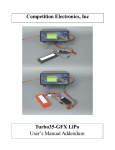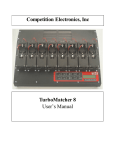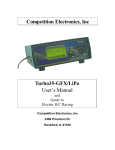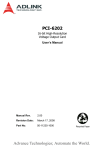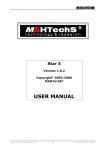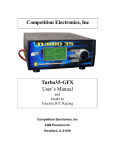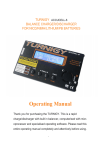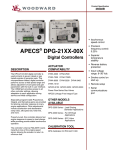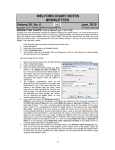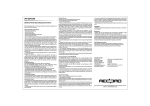Download Competition Electronics, Inc Turbo35
Transcript
Competition Electronics, Inc Turbo35-GFX LiPo User’s Manual Addendum Competition Electronics, Inc 3469 Precision Dr. Rockford, IL 61109 1 Introduction This enhancement makes it possible to charge 1,2 and 3 cell LiPo battery packs with the T35-GFX. Now you can have the accuracy and reliability of the T35-GFX for LiPo charging, as well as NimH/NiCd charging. Safety Considerations WARNING: Please read before using your Turbo35-GFX LiPo charger/discharger: IMPORTANT SAFETY INSTRUCTIONS AND WARNINGS • You must read these safety instructions and warnings before using the Turbo35-GFX LiPo battery charger. • Lithium Polymer batteries are volatile. Failure to read and follow the below instructions may result in fire, personal injury and damage to property if charged or used improperly. • Competition Electronics, Inc, its distributors or retailers assume no liability for failures to comply with these warnings and safety guidelines. General Guidelines and Warnings 1) Use only the LiPo mode, never the NimH/NiCd mode, to charge and discharge LiPo batteries. Failure to do so may a cause fire, which may result in personal injury and property damage. Likewise, do not attempt to work with NimH/NiCd packs in LiPo mode. 2) Never charge batteries unattended. When charging LiPo batteries you should always remain in constant observation to monitor the charging process and react to potential problems that may occur. 3) If at any time you witness a battery starting to balloon or swell up, discontinue the charging process immediately, disconnect the battery and observe it in a safe place for approximately 15 minutes. This may cause the battery to leak, and the reaction with air may cause the chemicals to ignite, resulting in fire. 4) Since delayed chemical reaction can occur, it is best to observe the battery as a safety precaution. Battery observation should occur in a safe area outside of any building or vehicle and away from any combustible material. 5) Wire lead shorts can cause fire! If you accidentally short the wires, the battery must be placed in a safe area for observation for approximately 15 minutes. Additionally, if a short occurs and contact is made with metal (such as rings on your hand), severe injuries may occur due to the LiPo pack's ability to supply massive amperage. 6) A battery can still ignite even after 10 minutes. 7) In the event of a crash, avoid any charging or discharging of a LiPo battery until you have placed it in a safe open area away from any combustible material and observed it for approximately 15 minutes. 8) Never store, charge or discharge battery pack inside your car in extreme temperatures, since extreme temperature could ignite fire. 2 9) Monitor the condition of your LiPo packs and discontinue use when performance degrades or changes significantly. 10) OBSERVE PROPER POLARITIES BETWEEN CHARGER AND PACK WITHOUT FAIL. Charging Process 1) Never charge batteries unattended. 2) Charge in an isolated area, away from other flammable materials. 3) Let battery cool down to ambient temperature before charging. 4) Do not charge batteries packs in series. Charge each battery pack individually. Failure to do so may result in incorrect battery recognition and charging functions. Overcharging may occur and fire may be the result. 5) When selecting the cell count or voltage for charging purposes, select the cell count and voltage as it appears on the battery label. As a safety precaution, please confirm the information printed on the battery is correct. 6) Selecting a cell count other than the one printed on the battery (always confirm label is correct), can cause fire. 7) You must check the pack voltage before charging. It is not advisable to attempt to charge any pack if open voltage per cell is less than 3.3v. If you insist and the per cell voltage is greater than 2.3 volts, the Turbo35-GFX LiPo will charge the pack at a reduced current for 2 minutes in an attempt to reach at least 3V per cell. However, chances are the pack is damaged and will need replacement. 8) CEI recommends charging at 1C rate or less (one times the mAHr capacity of the battery), unless the manufacturer specifically recommends otherwise. Caring for Battery 1) Do not discharge battery to a level below 3V per cell under load. Deep discharge below 3V per cell can deteriorate battery performance. 2) Use caution to avoid puncture of the cell. Puncture of cells may cause a fire. Operating Temperature Typical Charge temperatures: Typical Discharge temperatures: 32 to 113 degrees F 32 to 140 degrees F 2) Consult the specific manufacturer's data sheet before charging or discharging a LiPo battery. 2) Let battery cool down to an ambient temperature before charging. 3) During discharge and handling of batteries, do not exceed 160 degrees F. 3 Significant Changes in the Turbo-GFX LiPo Charger In order to add the LiPo capability, the scrolling help message system in the Turbo35-GFX LiPo was eliminated. In addition, the number of storable setups for the NimH/NiCd function has been reduced to 5, in order to free up 5 setups for the LiPo mode. However, no other functionality was removed. Navigating the LiPo screens is no different than navigating the original NimH/NiCd screens, with this exception: not all the calculated and measured data produced with NimH/NiCd packs makes sense with LiPo packs, so certain data has been eliminated in the LiPo mode. Connecting the Turbo35-GFX Lipo to a LiPo Pack The hazards to both the battery and operator associated with shorting out or reversing polarity to LiPo packs make it essential that care is taken with connections between the Turbo35-GFX LiPo and the pack. Smaller packs, such as transmitter packs or packs used for airplanes often come with a pin and socket type connector, or a Dean's connector already assembled to the pack. If the connector ampacity is sufficient for the discharge rate, it is suggested that you obtain a mating connector and afix it to the GFX contacts in such a way that no short or polarity reversal is possible. Larger packs such as those intended for R/C cars, often have low resistance, gold-plated barrel-type connectors. In this case, CEI recommends obtaining the proper mating connectors and connecting them to the Turbo35-GFX LiPo output leads in such a way that shorting of the pack is not possible. In this case, it is recommended that similar proper mating connectors be directly attached to the Turbo35-GFX LiPo output leads. For convenience, you can use suitable connectors, such as Dean's connectors, on the sense and power leads. Then, make plug-in harnesses for different pack types; terminate the NimH/NiCd harness with the usual large and small alligator clips. Terminate the LiPo harness with a pair of high quality barrel connectors specifically designed to mate with the LiPo pack. CEI DOES NOT recommend using alligator clips or any dissimilar connector to directly connect to the LiPo pack's recessed terminals. In addition, avoid lots of floppy alligator-clipped connections with LiPo packsMake the connections as simple as possible, and as short as practical. Sense Leads ALWAYS USE THE SENSE LEADS WITH LiPo PACKS. If your pack has high current barrel connectors such as those mentioned above, then it is best if you mate the sense leads with their respective polarity power leads directly at the barrel connector. Crimp or solder both power and sense lead directly into the mating barrel connector. Soldering is the preferred method. In any case, always try to connect the sense leads as close to the actual cell contacts as possible, and try to assure that current through the sense leads does not travel through any more connections than is 4 necessary. For example, if you have bare leads coming from your LiPo pack, make sure both the sense and power leads of the Turbo35-GFX LiPo charger connect DIRECTLY to the bare leads, and do not simply clip or attach the sense lead clips to the power lead's alligator clips. Powering up the Turbo-GFX LiPo: Selecting Cell Type The first thing you will notice after the T35-GFX LiPo shows the sign on screen is the Cell Type selection screen. Here, you can use the rotary encoder dial to select either NimH/NiCd or LiPo chemistry. The unit defaults to NimH/NiCd but if you select LiPo and then store the setup, the next time it will default to LiPo mode. A scrolling message will appear at the bottom of the screen indicating that the T35-GFX LiPo is in LiPo mode. NimH/NiCd mode The NimH/NiCd operation mode is unchanged from the previous version, except that there will be a scrolling message at the bottom indicating that the unit is in NimH/NiCd mode. Please consult the original manual, found at www.competitionelectronics.com under Turbo35-GFX if you have questions. LiPo Mode The Turbo35-GFX LiPo mode allows charging of LiPo packs consisting of 1, 2 or 3 cells at up to 12000 mAHr rates. LiPo packs require a constant current charge process when the voltage is below 4.2 volts per cell. After the voltage threshold of 4.2V per cell is reached, the charge mode will switch into a constant voltage mode and maintain the pack voltage at (4.2V times # of cells) until current drops to roughly 3% of the mAHr setpoint. At this point the charge is terminated. The Turbo35-GFX LiPo can discharge a LiPo pack at up to a 35 amp rate. The discharge is terminated when the pack voltage reaches (3V times # of cells) while under load. Charging with the Turbo-GFX LiPo A charge display page has been added to the Turbo35-GFX LiPo which is very much like the existing charge page for NimH/NiCd packs. There are three significant settings for charging/discharging LiPo battery packs, as follows: Max Charge Seconds This is a user-settable safety time limit that will shut off the charge and signal an error if the charge time becomes equal to the setting. It is just another safety device which may be useful in the event of a malfunctioning LiPo pack. You should determine the typical charge time for a given LiPo pack at a given mAHr rate, and then set this just a bit longer. It is also useful as a way to put a partial charge into a pack for the purpose of storage. 5 No of Cells Always make sure the number of cells set into this setting agrees with the number of cells specified on the LiPo pack. Charge mAHrs Set this to the mAHr rating on your LiPo pack label. The Turbo35-GFX LiPo will charge at the ampere rate which will result in full mAHrs delivered in 1 hours time. For example if you have a 3200 mAHr pack, set the mAHr setpoint for 3200 and the Turbo35-GFX will charge at a rate of 3.2 amps. Some manufacturers of LiPo packs specify the ability to charge at 2C, or even 3C rates. Check your manufacturer's pack data to determine if this is acceptable to your pack. At the time of this writing it is generally the case that charge rates higher than 1C can shorten the life of the LiPo pack. NOTE: Unless specifically allowed by the manufacturer of the LiPo pack in question, never exceed a 1C charge rate. Under and Overvoltage Considerations LiPo charge will be disabled and an error message displayed if the pack voltage exceeds 4.3V per cell or if is is less than 2.3V per cell. If the LiPo pack voltage is between 2.3V and 3V per cell, the Turbo35-GFX LiPo will try to charge the pack at approx. 10% of the mAHr rate setpoint for 2 minutes in an effort to restore the pack voltage to 3V per cell. If the pack does not return to this level after 2 minutes, the charge cycle is terminated and an error message is displayed. Discharging with the Turbo-GFX LiPo The Turbo35-GFX LiPo is capable of discharging continuously at up to 35 Amps. For some LiPo packs, this will cause the pack to exceed it's maximum safe temperature. Usually, this is around 140 deg F. Exceeding the maximum temperature can cause fire or explosion. Consult the manufacturer's data sheet for details concerning the maximum temperature for your pack. Always observe maximum discharge rates specified by the manufacturer, as well. If in doubt contact them and ask them directly. The Discharge display page contains three settable parameters: Discharge Amps Settable between .5 and 35 amps. Observe all precautions under “Discharging with the Turbo35-GFX LiPo, above. No of Cells Always make sure the number of cells set into this setting agrees with the number of cells specified on the LiPo pack. 6 AIR On/Off For higher charge rates, the Turbo35-GFX LiPo will measure actual internal resistance at 121 seconds into the discharge cycle. AIR measurement is disabled for discharge rates of 10 amps and below. Under and Overvoltage Considerations NOTE: As with charging, there are under and over voltage checks built in which will terminate discharge if it can be determined that there is an abnormality. Cycling with the Turbo-GFX LiPo Cycling in LiPo mode works as you would expect; it first runs the LiPo charge and then the LiPo discharge functions. Storing and Retrieving Program Setups Storage and retrieval of setups works the same way as with the original T35-GFX, however, there are only 5 setups available in NimH/NiCD mode and 5 setups available in LiPo mode. See the T35-GFX manual for details. Generic setups have been provided for both NimH/NiCd and LiPo packs as a starting point and a convenience to the user. It is the responsibility of the user to understand, select and adjust these setups to suit specific packs. This manual and its contents ©2007 Competition Electronics, Inc. 7







